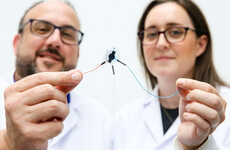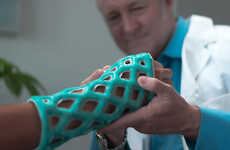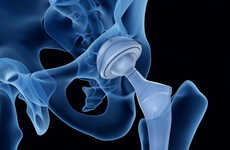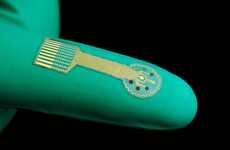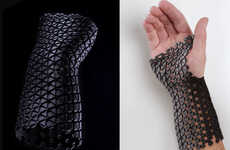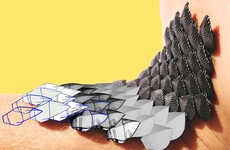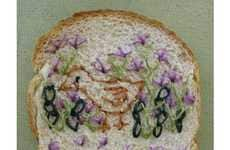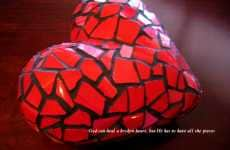
Trend Spotter — January 1, 2006 — Science
References: time
It's like the paper snowflakes you made in grade school, only in this case it gets implanted into your body after your shoulder surgery.
"It may look like a delicate doily, but the Bioimplantable Device is a rugged internal bandage that helps patients recover swiftly from shoulder-joint-replacement surgery. Made of standard polyester surgical thread, the device has an embroidered pattern that gives it strength and flexibility while imitating human tendons. Once implanted between muscles and bones, the device is never removed; it becomes part of the body as cells grow over it. This technology is also being used to replace slipped disks in the neck and to aid in clavicle-replacement surgery." - Time
From the Ellis Website:
The objective of the project was to investigate the use of embroidery techniques for the manufacture of surgical implants. The project developed a technical demonstrator in the form of a graft stent for the repair of abdominal aortic aneurysms using endovascular techniques.
The project used the demonstrator to show that fibre placement using embroidery could be applied not only to textile fibres using the CADCAM techniques of modern embroidery systems, but the placement of metallic shape memory alloy wire.
Existing fibre placement techniques were developed through the use of software and stimulated development of associated methodologies and design techniques.
In the rapidly moving world of endovascular surgery, a product requirement specification that changed throughout the project demonstrated that the technology could keep pace with the fast changing demands of the surgeons. The project has also stimulated an enhanced understanding of the problems of endovascular techniques and an MD thesis is now in preparation as a result of an underlying programme to understand attachment of the endovascular graft stent to human aortae.
"It may look like a delicate doily, but the Bioimplantable Device is a rugged internal bandage that helps patients recover swiftly from shoulder-joint-replacement surgery. Made of standard polyester surgical thread, the device has an embroidered pattern that gives it strength and flexibility while imitating human tendons. Once implanted between muscles and bones, the device is never removed; it becomes part of the body as cells grow over it. This technology is also being used to replace slipped disks in the neck and to aid in clavicle-replacement surgery." - Time
From the Ellis Website:
The objective of the project was to investigate the use of embroidery techniques for the manufacture of surgical implants. The project developed a technical demonstrator in the form of a graft stent for the repair of abdominal aortic aneurysms using endovascular techniques.
The project used the demonstrator to show that fibre placement using embroidery could be applied not only to textile fibres using the CADCAM techniques of modern embroidery systems, but the placement of metallic shape memory alloy wire.
Existing fibre placement techniques were developed through the use of software and stimulated development of associated methodologies and design techniques.
In the rapidly moving world of endovascular surgery, a product requirement specification that changed throughout the project demonstrated that the technology could keep pace with the fast changing demands of the surgeons. The project has also stimulated an enhanced understanding of the problems of endovascular techniques and an MD thesis is now in preparation as a result of an underlying programme to understand attachment of the endovascular graft stent to human aortae.
Trend Themes
1. Bioimplantable Devices - The use of embroidery techniques for manufacturing surgical implants, like the internal bandage, showcases the potential of bioimplantable devices to enhance patient recovery and improve surgical procedures.
2. Endovascular Techniques - The development of embroidery-based technologies for endovascular surgery demonstrates the potential of this approach to keep pace with the evolving demands of surgeons and enhance the efficacy of procedures.
3. Fiber Placement Techniques - The application of embroidery techniques for fiber placement, including the use of modern embroidery systems and shape memory alloy wire, opens up disruptive innovation opportunities for the manufacturing of surgical implants and medical devices.
Industry Implications
1. Medical Devices - The use of embroidery techniques for bioimplantable devices and endovascular surgery presents disruptive innovation opportunities within the medical devices industry to revolutionize surgical procedures and improve patient outcomes.
2. Textile Industry - The adoption of embroidery techniques for fiber placement in surgical implants drives potential innovation opportunities within the textile industry to develop advanced materials and techniques for medical applications.
3. Surgical Instrumentation - The integration of embroidery-based technologies in surgical procedures highlights disruptive innovation opportunities in the field of surgical instrumentation to enhance precision, flexibility, and patient recovery.
2.6
Score
Popularity
Activity
Freshness

